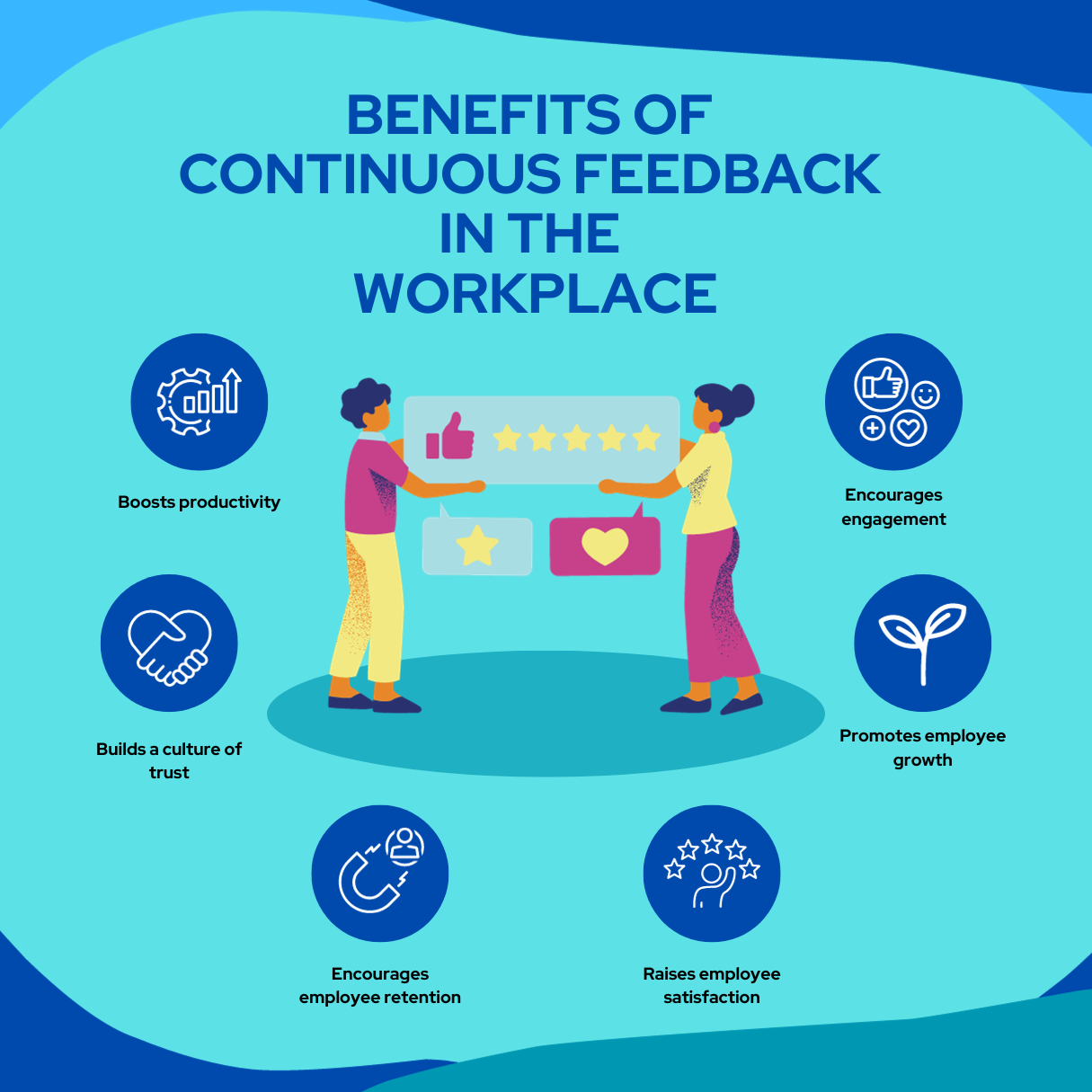Feedback is essential. Customer feedback is a way to improve products and services and foster trust as customers share their reviews.
But what about workplace feedback?
A culture of ongoing feedback can bring many benefits to your workplace. In this article, we explore the continuous feedback model. We’ll explain why it’s a good thing and how you can introduce it to your business to start reaping the benefits.
What is a continuous feedback culture?
So, what is a culture of continuous feedback? It’s a company culture that shares constructive feedback between management and employees. This includes suggestions, opinions, and performance reviews.
Companies will often have feedback loops and systems in their workforce management strategies. For example, management may hold standup meetings to gather and give timely feedback. Internal company communication tools may also provide an option for making anonymous suggestions.
Yet, a continuous feedback process is no good without a culture of open communication. You have to create a safe space for giving feedback to get that feedback flow. On top of this, encourage employee feedback through direct conversations. In this way, you enable a culture of continuous improvement and employee engagement.
But why should you go to all this effort in the first place?
Let’s look at the benefits of a culture of ongoing feedback in the workforce.
Why is continuous feedback important?
Continuous feedback has enormous benefits for your workforce, including:
- Productivity. Feedback helps workers to feel empowered and included. This encourages staff to take the initiative and become more productive.
- Engagement. Greater employee engagement is always a good thing. Continuous feedback systems and culture encourage employee feedback. Giving team members a safe space to communicate can boost engagement and motivation.
- Staff growth. Providing internal feedback and involvement in decision-making empowers employees. It helps them to take the initiative, learn, and grow. It also allows team members to reflect on their work and consider improvements.
- Employee performance. Giving feedback to each employee regularly can improve their performance at work. Ensure the feedback process is part of your continuous performance management strategy.
- A culture of trust. Building a culture of continuous management and employee feedback encourages trust between team leaders and staff. Open communication also increases understanding between different roles.
- Employee satisfaction. Employees feel respected when there is a culture of continuous feedback. It also allows bosses to make the changes employees want to see in the workplace. This is great for employee satisfaction.
- Employee retention. Employee retention goes hand-in-hand with increased employee satisfaction, empowerment, and trust. Employees are less likely to leave a company with a culture of continuous feedback.

How to build a culture of continuous feedback
All sounds pretty good, right? So, how can you foster this culture in your own company?
Let’s take a look.
Schedule regular feedback meetings
Nobody likes a meeting-filled schedule. But feedback meetings don’t have to be long or pointless. Instead, encouraging frequent conversations on an ongoing basis opens up lines of communication.
Regular meetings give employees a chance to provide feedback in a more personal way. They can also result in productive discussions about any issues raised.
A meeting doesn’t have to be an official performance review. You can structure feedback meetings in whatever way works best for each employee. If your team is remote, consider video conferencing tools like Zoom, Slack Huddle, or Google Meet.
Try a weekly standup meeting or bi-monthly one-to-one for hybrid or office-based teams. Monthly team meetings are also effective.
It is worth providing feedback during performance reviews and annual appraisals. This should form part of your continuous performance management strategy. You’ll be able to track employee performance and ensure continuous improvement. Combined with regular check-ins, this shows commitment to employees’ professional development.
This also ensures employees see feedback as a chance to grow. By turning feedback into performance goals, you give employees something actionable.
No matter the meeting style, make sure the schedule and structure work for everyone. You also want to ensure that everyone feels comfortable sharing and receiving feedback.
Note: don’t overdo it with meetings. Some companies run into the issue of having too many calls. This leaves little time to do actual work. So, be strategic about meetings.
Foster trust and transparency
Fostering trust is not as easy as walking into the staffroom and saying, “Hey guys! You can trust me! Tell me all your concerns!”

Trust is something you have to work on constantly. But building trust to get that continuous feedback culture is worth working on.
Requesting feedback is challenging due to the power imbalance between managers and employees. For example, employees may feel that their feedback will reflect on their performance. As a result, they will keep negative feedback to themselves. This can make it difficult for you to improve on issues, as you don’t know they exist.
So, you need to foster trust and transparency within your workforce culture.
How can you do this? It’s an ongoing process, but it’s good to start at the beginning. Emphasize your culture of trust at onboarding. Prove to employees that they can trust you whenever you get the opportunity. Listen to employee concerns and provide reassurances.
You can also improve trust by being transparent. For example, you might use HR and payroll software with self-service features. This kind of transparency is empowering and reassuring for employees. It could make them more inclined to return your trust.
Make sure that the chain of communication flows in all directions
How free-flowing is your chain of communication? Is employee feedback offered freely? Or do staff keep their thoughts to themselves?
To find out, analyze who sends the most feedback, queries, and opinion-based communications. This will help you discover who uses their voice and who doesn’t feel they can.
People should feel free to voice their thoughts and opinions to their superiors. For this, your chain of communication needs to flow upwards and downwards. You may have to adjust your communications or switch your comms tools to achieve this.
Which leads us to…
Use technology
Technology can make a massive difference to your feedback culture. Here are some ideas for using it to encourage a culture of continuous feedback.
- Test new communication tools like instant messaging apps like Slack or your email provider’s chat function.
- Use QR codes to link employees to feedback surveys. For example, Adobe Express has a free but comprehensive QR code generator. This allows you to personalize the design to match your branding.
- Add anonymous feedback shortcuts to work tools and platforms. This might include buttons or links on collaboration tools or task managers like ClickUp and Basecamp.
- Use analytics tools to check feedback patterns. Tools like Canny.io allow you to analyze feedback to inform future decisions.
Finding the right feedback tools and platforms to suit your staff culture might be a trial and error process. So don’t be afraid to demo various apps and software solutions until you find the right fit.
Hold 360 feedback reviews
The traditional feedback process only considers feedback from an employee’s manager.
However, a 360 feedback process is more comprehensive. It gathers input from colleagues and reporting staff of that employee. Even customers can provide feedback. This gives you complete insight into your staff, team, system, and problem.
Collecting feedback from many sources gives you a complete view of your business performance. But you must also ensure this comes from different levels.
The same applies to specific systems. Seek feedback from users and those responsible for running and maintaining it. Then, combine this information with system data to gain better insights.
360 reviews are excellent. They give you a holistic and unbiased view of teams, workflows, and systems.
Provide safety and anonymity
Remember earlier when we talked about trust? No matter how great you build trust, some people will always be wary of sharing criticism. This can hamper employee engagement and satisfaction.
For this reason, make sure that employees can share anonymous feedback.
It’s crucial that employees feel safe in their anonymity. So, provide reassurances that there is no way to trace criticism back to them. Emphasize how negative feedback is necessary for the improvement process.
Things like anonymous feedback forms can be helpful here. You could also look into anonymous suggestion apps like SurveyMonkey or Incogneato.
Finally, remember to treat anonymous and non-anonymous feedback the same. Everyone should feel comfortable giving feedback, whether it’s anonymous or not.
Boost employee engagement with a culture of continuous feedback
Continuous feedback may not always be comfortable to hear. However, the insights you get through feedback can benefit your business. Creating a culture of trust can improve employee engagement, productivity, and performance management.
Remember, though, there’s more to feedback than receiving it. It doesn’t matter whether feedback comes from a stand-up meeting or performance review. You must listen and act on it. Otherwise, there’s no point in the culture you’ve worked so hard to build.
Consider all the feedback you receive with care. Let your team know that you’ve heard them, value their opinion, and will act on it. This will encourage further feedback that creates a positive, motivated workforce.






